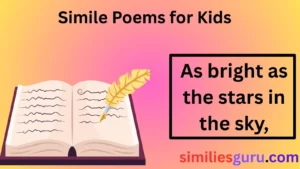Similes and metaphors are powerful tools in the English language, often used to enrich communication, enhance writing, and deepen understanding of complex ideas. As a result, these literary devices are fundamental in education, particularly in language arts classrooms. Teaching and practicing similes and metaphors can be both fun and effective, providing students with the necessary skills to communicate with vivid imagery and depth. This article explores 15+ engaging activities for similes and metaphors that can help students develop their literary skills in both formal and informal contexts.
In addition to offering structured activities, this article also presents a variety of professional, polite, and casual alternatives to the phrase “activities for similes and metaphors.” It aims to inspire creativity and encourage teachers, parents, and learners to explore these devices through various engaging exercises. Throughout this article, we’ll discuss practical ways to introduce similes and metaphors in a way that is accessible, enjoyable, and educational.
What Are Similes and Metaphors?
Before diving into activities, let’s briefly define the two devices:
- Similes are comparisons between two different things using the words “like” or “as.” For example: “Her smile was as bright as the sun.”
- Metaphors make direct comparisons between two things by saying one thing is another. For example: “The world is a stage.”
Both similes and metaphors allow speakers and writers to convey meaning more effectively by drawing comparisons that highlight particular qualities of the objects or concepts they are describing. These comparisons help the audience visualize ideas in ways that are more concrete or relatable.
Activities for Similes and Metaphors
Below are 15+ activities designed to help students understand and apply similes and metaphors in a variety of contexts. These activities are suitable for both classroom and casual learning environments and encourage creativity and exploration of language.
1. Simile and Metaphor Scavenger Hunt
Description: This interactive activity involves students searching for examples of similes and metaphors in books, magazines, or online articles. Students can work individually or in teams. The goal is to find at least five similes and five metaphors, and then explain their meanings and contexts.
Why it works: This activity encourages students to engage with different types of texts and recognize literary devices in real-world situations.
2. Simile and Metaphor Matching Game
Description: Create a set of cards, each with a simile or metaphor on one side and its definition or explanation on the other. Mix the cards up and have students work in pairs or small groups to match each simile or metaphor with its correct definition or example.
Why it works: It helps students practice identifying and understanding the meaning of literary devices while making learning fun.
3. Simile and Metaphor Rewrite Challenge
Description: Present students with a paragraph that contains simple descriptions or straightforward statements. Ask them to rewrite the paragraph using at least three similes and three metaphors.
Why it works: This activity promotes creative thinking and allows students to apply their knowledge of similes and metaphors in a writing context.
4. Simile and Metaphor Storytelling
Description: Have students write short stories or paragraphs using a mix of similes and metaphors. To make it more engaging, they could work with a theme (e.g., nature, friendship, or a magical adventure).
Why it works: Storytelling encourages students to use figurative language in context, enhancing their ability to incorporate similes and metaphors naturally in their writing.
5. Simile and Metaphor Art Project
Description: Ask students to draw or paint an image that represents a particular simile or metaphor. For example, they might draw a heart with “as cold as ice” written across it or a person standing on top of a mountain representing the metaphor “life is a journey.”
Why it works: This activity allows students to express their understanding of figurative language visually, reinforcing their learning in a creative manner.
6. Metaphor Creation Challenge
Description: Challenge students to create new metaphors for ordinary objects. For example, they could describe “a pencil” as “a small sword of knowledge” or “the moon” as “a glowing lantern in the sky.”
Why it works: Creating original metaphors deepens understanding and promotes the development of creative language skills.
7. Simile and Metaphor Charades
Description: Play a game of charades where one student acts out a simile or metaphor (e.g., “as fast as a cheetah” or “the world is a book”) and the others have to guess the phrase.
Why it works: This physical activity helps students internalize figurative language by associating it with actions and visual cues.
8. Simile and Metaphor Pictionary
Description: In this game, students take turns drawing pictures that represent different similes or metaphors. The rest of the class must guess the phrase based on the drawing.
Why it works: Like charades, Pictionary helps students engage with figurative language in an interactive and fun way.
9. Simile and Metaphor Comparison Chart
Description: Create a comparison chart with columns for similes, metaphors, and their meanings. Students can work individually or in pairs to fill out the chart using examples from books, poems, or songs.
Why it works: This activity helps students categorize and analyze different types of figurative language in an organized way.
10. Simile and Metaphor in Song Lyrics
Description: Students listen to a song with well-known lyrics and identify similes and metaphors in the song. Afterward, they can discuss the impact these literary devices have on the song’s meaning or mood.
Why it works: This activity connects figurative language with popular culture, making it more relatable and engaging for students.
11. Simile and Metaphor in Advertising
Description: Show students different advertisements (print, digital, or television) and have them identify any similes or metaphors used to promote the product. Discuss how these devices influence consumer perception.
Why it works: This activity helps students understand how similes and metaphors are used in persuasive writing and marketing, adding a real-world application to their learning.
12. Simile and Metaphor Poetry
Description: Encourage students to write poems that use a combination of similes and metaphors. Provide them with a theme or topic (e.g., seasons, emotions, nature) and have them incorporate at least five similes and five metaphors into their work.
Why it works: Writing poetry allows students to experiment with figurative language in a creative and expressive way, enhancing their poetic and language skills.
13. Simile and Metaphor Roleplay
Description: Have students roleplay a scene from a story or a real-life situation using similes and metaphors to describe emotions or actions. For example, a character might describe a storm as “the sky’s anger,” or “her voice was a soft melody.”
Why it works: Roleplaying allows students to practice using figurative language in conversation, building both verbal and creative skills.
14. Simile and Metaphor Word Bank
Description: Create a word bank filled with descriptive words and phrases, and have students build their own similes and metaphors. For example, they could combine the word “fire” with various adjectives like “blazing,” “fiery,” or “warm” to create unique similes and metaphors.
Why it works: A word bank provides students with inspiration and encourages them to experiment with different combinations to enhance their language.
15. Simile and Metaphor Word Association
Description: In this activity, students take turns saying a word, and the next student must respond with a simile or metaphor that relates to the previous word. For example, if the first student says “cloud,” the next might respond with “a cloud as fluffy as cotton candy.”
Why it works: This activity promotes quick thinking and creativity while helping students reinforce their understanding of figurative language.
11 Texting Examples for Similes and Metaphors
- “Your laughter is like music to my ears. 🎶”
- “She’s as graceful as a swan on a lake. 🦢”
- “Life is a rollercoaster of emotions, but I’m enjoying the ride! 🎢”
- “That meeting was a battlefield—everyone was on edge! ⚔️”
- “The sun dipped below the horizon like a fiery orange ball. 🌅”
- “His mind is a labyrinth of ideas. 🧠”
- “I’m feeling as lost as a needle in a haystack today. 🤔”
- “Your smile lights up the room like a beacon in the dark. ✨”
- “She’s a storm waiting to happen—full of energy and excitement. ⚡”
- “The city never sleeps—it’s always buzzing like a beehive. 🐝”
- “That song is the soundtrack of my life, always on repeat. 🎧”
Conclusion
Similes and metaphors are essential for enhancing communication, and practicing them through these 15+ activities will help students become more proficient in their use. These activities range from fun, interactive games to creative writing exercises, ensuring that students engage with these literary devices in diverse and enjoyable ways. By understanding how to apply similes and metaphors in various contexts, students can sharpen their language skills and express themselves with greater clarity and creativity.
Whether you are a teacher, student, or just someone looking to improve their writing, these activities provide ample opportunities to practice and master similes and metaphors. The key is to explore different contexts, experiment with language, and have fun with these powerful tools that bring our words to life.



